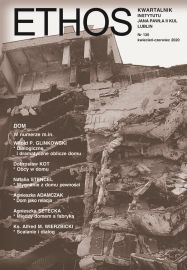MIĘDZY DOMEM A FABRYKĄ
MIĘDZY DOMEM A FABRYKĄ
Wiktoriańska koncepcja odrębnych sfer w powieści „Shirley” Charlotte Brontë
Author(s): Agnieszka SeteckaSubject(s): Theology and Religion
Published by: Katolicki Uniwersytet Lubelski Jana Pawła II - Instytut Jana Pawła II, Wydział Filozofii
Keywords: Charlotte Brontë; Shirle; domestic sphere; public sphere; women’s position
Summary/Abstract: The idea of home and domesticity is crucial to understand Victorian culture. John Ruskin idealised home as “the place of Peace” and “the shelter, not only from all injury, but from all terror, doubt, and division.” Home was to offer protection from the dangers of the outside world, the public sphere, where men “must encounter all peril and trial,” and it was to be guarded by a woman, a domestic angel, who was constructed in Victorian culture as virtuous and wise. The ideology of the separate spheres, which assumed the distinction between the public and the private, dominated respectively by men and women, was manifest in the physical separation of home and factory evident at least since the end of the eighteenth century. Although the separation of the domestic and the public spheres constituted the major tenet of Victorian ideology, and women’s role within the realm of home seemed natural, a careful reading of Victorian fi ction might nevertheless reveal that it was not necessarily unquestioned or unconditionally accepted. Charlotte Brontë’s Shirley is one of the novels which disrupt the ideological representation of the angelic woman and the domestic sphere. Brontë’s own ambivalent attitudes to the conventional representations of women’s social roles earned her the opinion of a radical or a female rebel. However, as I will be trying to show in my article, such reputation is only partially justifi ed. In Shirley, the ideas challenging the dominant ideology concerning, for instance, the position of women seem contradicted by the rather conventional domestic plot and the happy ending. In other words, although the novel questions some of the aspects of the ideology of the separate spheres and exposes its inconsistencies by discussing the position of a spinster marginalised in the patriarchal society, as well as by representing unhappy marriages and discordant family relations, the happy ending of the novel seems to constitute a celebration of marriage, family life, and the separation of spheres. The period of anxiety, uncertainty and searching for a place in the world ends for the two female protagonists, Caroline and Shirley, when they marry. On their marriage, they readily accept the roles Ruskin imagined best for women and become perfect homemakers. Just like in the public sphere the period of social unrest ends when the markets open and the economic crisis ends, in the private sphere the protagonists’ marriage seems to end the period of anxiety and rebellion and consolidate the Victorian ideal of separate spheres.
Journal: Ethos. Kwartalnik Instytutu Jana Pawła II KUL
- Issue Year: 33/2020
- Issue No: 2
- Page Range: 249-267
- Page Count: 19
- Language: Polish
- Content File-PDF

